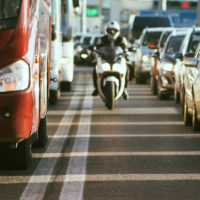Lane Splitting Officially Legal in California

After years of occupying an ambiguous grey zone of legality, and countless efforts to legalize or regulate the practice, California’s lane-splitting bill, AB 51, has been signed into law by Governor Jerry Brown. Lane splitting is now legal in California, making it the first state to sanction the practice which researchers have determined can save motorcyclists’ lives.
As we reported in July, an early version of the lane-splitting legalization bill contained restrictions on the speed at which motorcycles could travel while splitting lanes at a maximum speed of 50 mph, and only 15 mph faster than the traffic around them. The version of the bill which was passed by lawmakers and Gov. Brown stated only that the CHP would develop guidelines on safe lane-splitting. The California Vehicle Code already contains laws making it illegal to interfere with the path of motorcyclists, protecting them as they split lanes. Specifically, California Vehicle Code section 22400 prohibits drivers from impeding traffic by slowing down in front of another driver without good reason, and section 22517 prohibits passenger vehicle drivers from opening their door to interfere with another vehicle.
Now that the practice of lane splitting is officially legal, the question that remains is how the CHP will regulate the practice going forward. When lane splitting was not officially legal, there was not a speed at which a motorcyclist could be traveling where he or she was per se in violation of the law. This afforded both riders and law enforcement certain discretion regarding what was or was not safe for a lane-splitting motorcyclist. Now that the practice has received official state sanction, the CHP may develop more specific guidelines governing the practice, though AB 51 called for the CHP to develop only “educational guidelines.” It is possible that the CHP would simply reinstate the voluntary guidelines it developed in 2013, which instructed motorcyclists to refrain from splitting lanes at a speed over 30 mph, and not to travel more than 10 mph faster than neighboring traffic.
If you’ve experienced discrimination as a motorcyclist in the state of California, or have been injured by a negligent car or truck driver on Bay Area roads, seek help from the San Francisco motorcycle accident attorney who knows the law and stands up for bikers’ rights, and contact William Weiss for a consultation at 415-362-6765, or at williamweiss@gmail.com.
P.S. Thanks to Bobby Tabaldo for all the hard work and information you provided to the Biker community.
